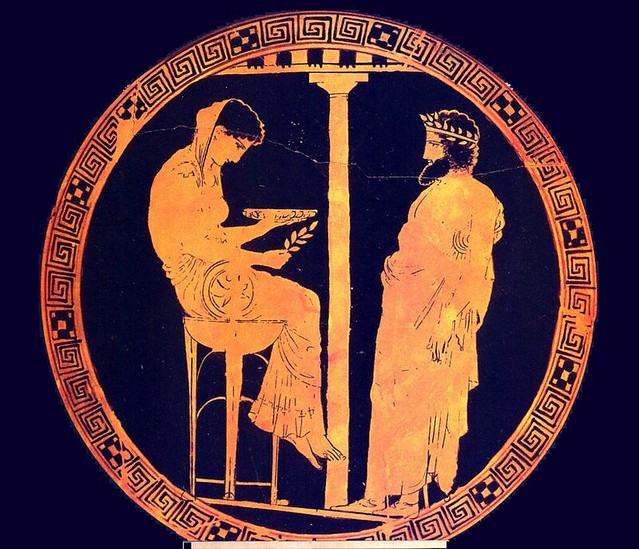
"The deepest core of life is poetry and symbol." - Dane Rudhyar
Like Symbol Reader on Facebook
-
-
Recent Posts
Categories
Archives
Meta










Tag Archives: Underworld
Sedna
The Inuit peoples have a profound connection to the Arctic as their ancestral homeland. Across the Arctic, one deity stands out as an all-powerful goddess of the sea and the underworld. Her name is Sedna. The name itself is an … Continue reading
Posted in Sedna, Sedna
Tagged Adlivun, archetypes, art, Bitternis, christianization, creation myth, Demeter, dismemberment, goddess, handicapped, Inuit myth, Joanna Bator, limbless, mutilation, mythology, Sedna, shaman, Soul, symbolism, symbols, trauma, Underworld, violence
2 Comments
Hekate: World Soul, Cosmic Bridge and a Liminal Goddess
“Ever since the ‘Timaeus’ it has been repeatedly stated that the soul is a sphere. As the anima mundi, the soul revolves with the world wheel, whose hub is the Pole. … The anima mundi is really the motor of … Continue reading
Posted in Hekate
Tagged anima mundi, Apuleius, archetypes, boundaries, C.G. Jung, cave, Chaldean Oracles, cosmic harmony, daimones, dogs, goddess, Greek myth, Hekate, Helios, Hellenistic era, Hesiod, iynx, Karians, keyholder, keys, kourothropos, liminality, limits, magic, Moon, Olympians, Persephone, Plato, Plutarch, Porphyry, Sibyl, sun, sunthemata, symbola, symbolism, symbols, sympathy, Theogony, theurgy, Titans, torches, Underworld, world soul, Zeus
3 Comments
Number Three and Its Mysteries
Three is intimately connected with the myth of the goddess and with the three main phases of the moon – waxing, full and waning, corresponding to the three phases of a woman’s life – maiden, mother and hag. Pythia sitting … Continue reading
Posted in three, Uncategorized
Tagged alchemy, archetypes, Aum, Binah, C.G. Jung, Cora, Demeter, Dion Fortune, duality, Ereshkigal, evil, force, form, four, Hekate, Holy Trinity, Inanna, Kabbalah, manifestation, Morrigan, numbers, Pillar of Severity, quaternio, Saturn, symbolism, symbols, The Tree of Life, three, Tridevi, Trimurti, triple goddess, Underworld
10 Comments
The Sirens as Psychopomps and Muses of the Underworld
I came across this beautiful description of the Sirens in Karl Kerenyi’s Gods of the Greeks (first published in 1951). It seems that far form being the evil seductresses often portrayed in literature, they were in fact guides of the … Continue reading
Posted in sirens
Tagged Acheloos, archetypes, death, Greek myth, Greek mythology, guide, Kerenyi, muse, music, psychopomp, sirens, Soul, sphinx, symbolism, symbols, Underworld
6 Comments
Symbolist Art: The Mysteriarch (The One Who Presides over Mysteries)
In volume V of Collected Works (Symbols of Transformation, par. 299) Jung quotes a passage from Goethe’s Faust, in which he hero must descend to the realm of the Mothers: “MEPHISTOPHELES: This lofty mystery I must now unfold.Goddesses throned in … Continue reading
Posted in Mysteriarch
Tagged archetypes, art, C.G. Jung, Faust, George James Frampton, Goethe, mothers, Mysteriarch, psyche, sculpture, symbolism, symbolist art, symbols, unconscious, Underworld
8 Comments
Gilgamesh: He Who Saw the Deep
If you happen to have some time on your hands, I strongly recommend that you take a look at Ancient Masterpiece of World Literature (https://www.edx.org/course/ancient-masterpieces-of-world-literature), a course which Harvard University is currently offering online free of charge. You can also … Continue reading
Posted in Gilgamesh, Uncategorized
Tagged archetypes, Carl Gustav Jung, cedar, culture, death, deluge, depth psychology, Divine, Enkidu, epic, flood, Gilgamesh, goddess, human, humbaba, immortality, Inanna, Ishtar, Mesopotamia, myth, mythology, nature, Rilke, Sumer, Sumerian, symbolism, symbols, Underworld, Uruk, Utnapishtim
12 Comments
A Reedeming Darkness of The Black Madonna
“Underneath all our conditioning, hidden in the crypt of our being, near the waters of life, the Black Virgin is enthroned with her Child, the dark latency of our own essential nature, that which we were always meant to be.” … Continue reading
Posted in The Black Madonna, The Dark Goddess, Uncategorized
Tagged alchemy, archetypes, Artemis, Black Madonna, body, Buddha, Buddhism, C.G. Jung, Chartres, Christianity, Cybele, Dark goddess, darkness, death, Einsiedeln, enlightenment, Ephesus, fertility, Gnosticism, goddess, isis, Lyons, Mary Magdalene, Montserrat, nothingness, paganism, Paris, Shulamite, shunyata, Songs of Songs, Sophia, Soul, spirituality, symbolism, symbols, tantra, Tara, Underworld, wisdom, womb
13 Comments
Reading The Red Book (13)
“In Mark 4.11 Jesus says to his disciples: ‘To you has been given the secret, mysterion, of the kingdom of God, but for those outside everything is in parables.’” (1) Jung divided The Red Book into two parts: Liber Primus … Continue reading
Posted in The Red Book by C.G. Jung, Uncategorized
Tagged apotheosis, Apuleius, C.G. Jung, Christ, deification, individuation, initiation, isis, Liber Novus, Lion, Mithra, Mithraism, mysteries, opposites, Sol Invictus, symbolism, symbols, The Red Book, Underworld
7 Comments
Reading The Red Book (11)
“I am all that has been and is and shall be; and no mortal has ever lifted my veil.” (the words inscribed on the statue of Isis of Sais) The title of Chapter IX of The Red Book (Liber Primus) … Continue reading
Posted in The Red Book by C.G. Jung, Uncategorized
Tagged analytical psychology, anima, archetypes, blindness, C.G. Jung, Carl Jung, dance, dance of the seven veils, Dark goddess, depth psychology, descent, earth mother, Elijah, Eros, goddess, Gustave Moreau, Inanna, Ishtar, logos, Moon, myth, mythology, opposites, Oscar Wilde, pleasure, prophet, Salome, serpent, snake, symbolism, symbols, The Red Book, thinking, Underworld, veil
8 Comments
Reading The Red Book (10)
“The good and the beautiful freeze to the ice of the absolute idea and the bad and hateful become mud puddles full of crazy life.” C.G. Jung, The Red Book (Liber Primus, chapter VIII) Chapter VIII of The Red Book (Liber Primus) … Continue reading
Posted in The Red Book by C.G. Jung, Uncategorized
Tagged analytical psychology, archetypes, C.G. Jung, child, Christ, depth psychology, divine child, God, hell, Jungian psychology, mustard seed, opposites, psyche, seed, Soul, symbols, The Red Book, Underworld
9 Comments

